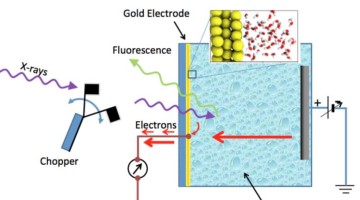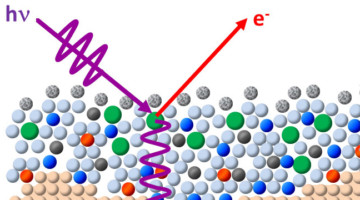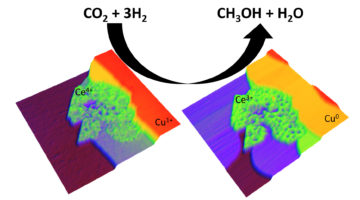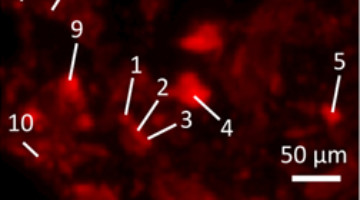Recently a team of Stanford and Berkeley Lab researchers used x-rays at the ALS in a novel way to observe the behavior of electrons during technologically important chemical reactions in metal oxide electrocatalysts. What they learned has upended long-held scientific understanding of how these catalysts work. Read more »![]()
![]()
ALS Work Using Spectroscopy
These techniques are used to study the energies of particles that are emitted or absorbed by samples that are exposed to the light-source beam and are commonly used to determine the characteristics of chemical bonding and electron motion.
Molecular Structure of Water at Gold Electrodes Revealed
ALS researchers have now made a first-ever observation of the molecular structure of liquid water at a gold surface under different charging conditions. This marks the first time that the scientific community has been able to achieve such high sensitivity in an in situ environment under working electrode conditions. Read more »![]()
![]()
Antiferromagnetic Spins Do The Twist
At ALS Beamline 4.0.2, researchers have found that the spins in an antiferromagnetic nanolayer perform a version of “The Twist,” turning one way and then the other, challenging a model that has been a cornerstone of exchange-bias theory for 27 years.
Read more »
New Technique Gives a Deeper Look into the Chemistry of Interfaces
A new technique developed at the ALS offers sub-nanometer depth resolution of every chemical element to be found at heterogeneous interfaces, such as those in batteries and fuel cells. The technique has relevance to energy research, heterogeneous catalysis, electrochemistry, and atmospheric and environmental science. Read more »![]()
![]()
ALS Director’s Update: Reflections on our Past, Present, and Future
We are looking forward to an exciting and productive year at the ALS, with plans for new beamlines and capabilities coming online, and more users taking advantage of our technical and scientific expertise to produce a record number publications. At the ALS, we are encouraged by this year’s funding and are looking for new ways to focus on our core strengths while expanding partnerships to explore new opportunities. Read more »
From CO2 to Methanol via Novel Nanocatalysts
Researchers have found novel nanocatalysts that lower the barrier to converting carbon dioxide—an abundant greenhouse gas—into methanol—a key commodity used to produce numerous industrial chemicals and fuels. In one case, it worked almost 90 times faster than catalysts commonly used for this reaction today. Read more »![]()
![]()
The Electronic Structure of a Two-Dimensional Pure Copper Oxide Lattice
All superconducting cuprates share a common structure: charge reservoirs stacked between layers of CuO2. An undoped version, including only C and O, is not available in nature. By growing epitaxial films with a pulsed-laser deposition facility, researchers stabilized a 2D version of CuO, which can be thought as composed by two CuO2 planes staggered and superposed.
An Iridate with Fermi Arcs
Researchers have discovered that “Fermi arcs,” much-debated features found in the electronic structure of high-temperature superconducting (HTSC) cuprates, can also be found in an iridate (iridium oxide) compound—strontium iridate. Read more »![]()
![]()
Infrared Mapping Helps Optimize Catalytic Reactions
A pathway to more effective and efficient synthesis of pharmaceuticals and other flow-reactor chemical products has been opened by a study in which, for the first time, the catalytic reactivity inside a microreactor was mapped in high resolution from start to finish. Read more »![]()
![]()
Iron is the Key to Preserving Dinosaur Soft Tissue
Researchers studying organic material from dinosaur bones have been able to show that the samples contained original soft tissue material from Mesozoic dinosaurs. The x-ray techniques at the ALS were key to showing a possible mechanism for this unexpected preservation.
Read more »![]()
![]()




